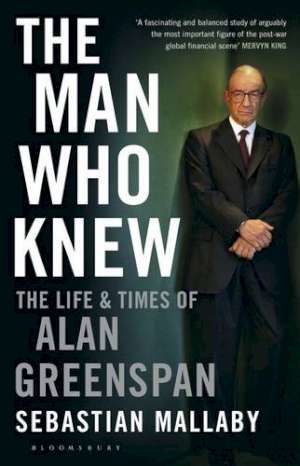09 November 2016
The Man Who Knew
The Life & Times of Alan Greenspan
Sebastian Mallaby
2016, Bloomsbury, 800 pages,
ISBN 9781408855782
Reviewer: Ian Harwood, Independent Economic & Investment Consultant

This is a splendid book and is recommended without reservation. While sub-titled the ‘Life and Times of Alan Greenspan’ it is no hagiography, let alone an ‘official’ biography; it is far too dispassionate and balanced for that. Nonetheless, author Mallaby appears to have enjoyed pretty much untrammelled access to his subject, as well as to many others whose paths joined Greenspan’s along the way. The outcome is a remarkably impressive and even-handed analysis of the career of a highly-ambitious man who ended up bestriding, Colossus-like, the global economic and financial firmament while Chairman of the Federal Reserve from August 1987 to January 2006.
While the text is almost 700 pages in length, this magisterial book – which took five years to research and write – is highly readable and, indeed, at times a veritable page-turner. Organised chronologically and, then by themes, it explores, in exceptionally interesting fashion, Alan Greenspan’s transition from entrepreneurial economic forecaster to successively more important positions in Washington’s corridors of power.
Most readers’ interest, however, is likely to focus upon Greenspan’s tenure at the Fed where he almost became the longest-serving chairman, having been reappointed four times – and by Presidents of differing political hues.
The challenges facing the Fed over this period were legion, as the world rapidly globalised and ‘financialised’ to an unparalleled and previously unimagined extent. Mallaby’s book takes us through these challenges, giving blow-by-blow accounts of how the Fed – often in conjunction with the White House and Congress – faced up to them. One intriguing counterpoint throughout the narrative is the way in which Greenspan’s beliefs – which, when he was younger, were of an untrammelled libertarian bent – morphed when addressing ‘real-world’ problems.
Mallaby’s insider treatment of landmark events – the October 1987 stock market crash, so eerily reminiscent of its 1929 predecessor ( the Fed response to which constituted the genesis of the ‘Greenspan put’); the 1989 Savings and Loans crisis; the 1993 bond market bubble; the 1994 Mexican bail-out and subsequent emerging market crises; the ‘productivity miracle’ of the late 1990s; the Japan-style deflation threat which emerged in the early 2000s, following the collapse of the dot.com boom and the shocking atrocity of 9/11 – is masterly. I am confident the insightful analysis will be savoured not just by those (like your reviewer) who lived through these extraordinary times but, also, by those to whom this constitutes the stuff of history.
Greenspan, of course, has his admirers and detractors. No other Fed chairman, moreover, has seen his reputation transmute from hero to villain so abruptly. In this connection, it is worth recalling that he was described, during the course of the valedictory August 2005 Jackson Hole retreat, as, “Probably the greatest central banker the world has ever seen.” And, indeed, it is undeniable that, on Greenspan’s watch, his predecessor Paul Volcker’s inflation-busting initiative was transformed into effective price stability and the US economy expanded robustly, suffering only two relatively mild recessions in 1990/91 and 2001 and delivering low unemployment.
Subsequently, of course, the unprecedented nationwide housing boom over which Greenspan had presided turned to bust, taking the overall economy down with it. And the US banking system, fatally undermined by the exponential and untrammelled expansion of financial derivatives, would have collapsed in the absence of extraordinary emergency support. Amidst all the controversy still surrounding Alan Greenspan’s reputation, Mallaby’s final chapter – which focuses upon the respective pluses and minuses of Greenspan’s lengthy career – is an exemplary model of finely-balanced judgement.
